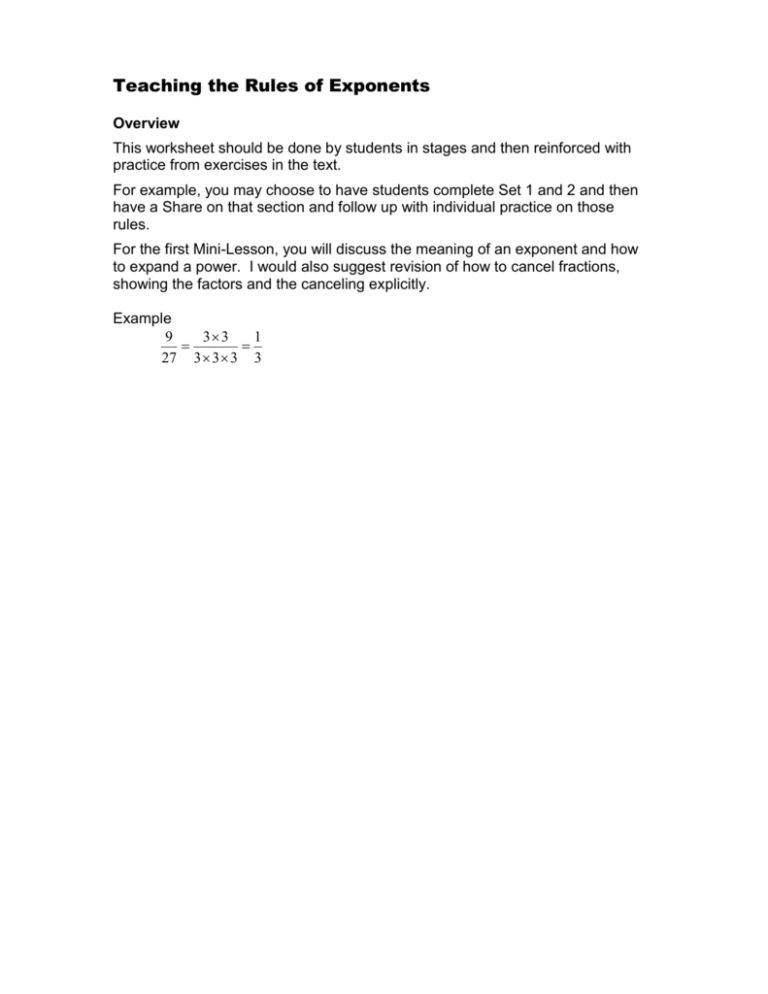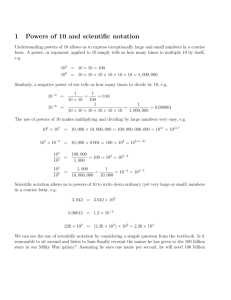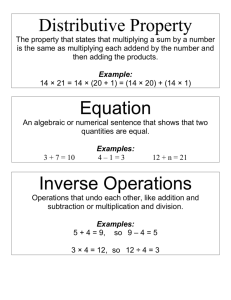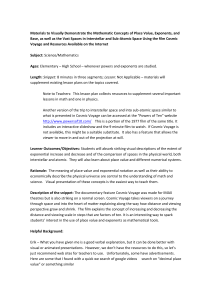Power Rules
advertisement

Teaching the Rules of Exponents Overview This worksheet should be done by students in stages and then reinforced with practice from exercises in the text. For example, you may choose to have students complete Set 1 and 2 and then have a Share on that section and follow up with individual practice on those rules. For the first Mini-Lesson, you will discuss the meaning of an exponent and how to expand a power. I would also suggest revision of how to cancel fractions, showing the factors and the canceling explicitly. Example 9 3 3 1 27 3 3 3 3 Power Rules Set 1 – Multiplying Powers with the Same Base Expand the following: 1. 23 2 4 2. 32 33 3. 5 4 56 4. 43 4 2 43 5. Can you see what the rule is for multiplying powers that have the same base? Write the rule here in words. _____________________________________________________________ _____________________________________________________________ _____________________________________________________________ In symbols: a m a n a __________ Set 2 – Dividing Powers with the Same Base 35 Consider 35 32 This can also be written as 2 3 In the following problem expand the numerator and denominator and then cancel out the common factors. Finally, write the answer as a power of 3. 35 1. 2 = -------------------------------------- = 3____ 3 Do the same with the following problems: 2. 26 23 3. 26 --------------------------------------- = 2 ___ 3 2 87 -------------------------------------------- = 8 ___ 84 68 4. 3 --------------------------------------------- = 6 ____ 6 5. m5 ---------------------------------------------- = m ___ 3 m Write the rule for dividing powers with the same base: ________________________________________________________________ ________________________________________________________________ In symbols: a m a n a __________ Set 3 – Power of a Power 1. Consider (34 )2 34 34 = = 3___ OR Using the rule for multiplying powers: (Expand) (34 )2 34 34 = 34 4 = 3___ Now do the same for these using one of the above methods: 2. (42 )3 3. (23 ) 4 = 4. (32 ) 4 = 5. (d 4 ) 2 = Write the rule in words for simplifying the power of a power. ________________________________________________________________ ________________________________________________________________ In symbols: (a m )n a ______ Set 4 – Power of a Product 1. Consider the following: (2 3) 2 (2 3) (2 3) = 2 3 2 3 = 2 2 3 3 = 2___ 2 ___ Do the same for these: 2. (4 3)3 3. (5 2)4 4. (6a)3 5. (5m) 2 What is the rule for simplifying the power of a product? ________________________________________________________________ ________________________________________________________________ In symbols: (ab)n a ___ b ____ Set 4 – Power of a Quotient 1. Consider the following: 32 62 32 (Expand) 62 3 3 = (Separate into fractions) 6 6 3 = ( ) ______ 6 =( ) 2 (Cancel down the fraction) Now try these: 2. 24 54 3. 43 123 4. a 5 b5 Write a rule for simplifying the power of a quotient: ________________________________________________________________ ________________________________________________________________ In symbols: am a _____ a b m ( ) b b m m Set 5 – Zero Exponent Complete the following and find the pattern: 25 32 35 243 105 100 000 2 4 16 34 81 104 10 000 23 33 103 22 32 102 21 31 101 20 30 100 We could do the same for other numbers and the process would be the same. What can you conclude about a number with an exponent of zero? ________________________________________________________________ ________________________________________________________________ In symbols: a0 ____ Another way to show this rule is true is to consider the following: 1. Consider 34 34 Method 1: Use the rule for dividing powers with the same base. 34 34 3 ___ 34 Method 2: 3 3 4 ------------------------------------ = _________ 3 4 4 (1.) (2.) Therefore, the answer in (1.) = the answer in (2.) So 3___ ____ Follow the same procedure for these: 2. 45 45 3. 52 52 4. a 3 a 3 So, once again, any number raised to the power zero is equal to _________







